
Pyrausta aerealis is a species of moth in the family Crambidae described by Jacob Hübner in 1793. It is found in most of Europe. It has also been recorded from Kyrgyzstan, Kazakhstan, Afghanistan, China and Algeria.

Pyrausta porphyralis is a species of moth in the family Crambidae described by Michael Denis and Ignaz Schiffermüller in 1775. It is found in most of Europe.

Pyrausta californicalis, the California pyrausta moth or Mint Moth, is a moth in the family Crambidae. It was described by Alpheus Spring Packard in 1873. It is found in North America, where it has been recorded from British Columbia to California.
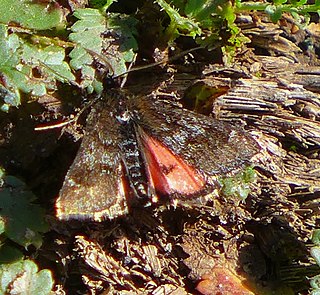
Pyrausta dapalis is a moth in the family Crambidae. It was described by Augustus Radcliffe Grote in 1881. It is found in western North America, where it has been recorded from California and Oregon.

Pyrausta fodinalis is a moth in the family Crambidae. It was described by Julius Lederer in 1863. It is found in North America, where it has been recorded from British Columbia to Quebec and the north-eastern United States. It is also present in California, Nevada, Colorado and Wyoming. The habitat consists of undisturbed prairie and grassland areas.

Pyrausta generosa is a moth in the family Crambidae. It was described by Augustus Radcliffe Grote and Coleman Townsend Robinson in 1867. It is found in North America, where it has been recorded from Ontario to Alberta and to Florida and Missouri. The habitat consists of undisturbed areas in aspen parkland and mixed woods.

Pyrausta homonymalis is a moth in the family Crambidae. It was described by Eugene G. Munroe in 1976. It is found in North America, where it has been recorded from Missouri to Virginia, Mississippi and Florida, west to Texas.

Pyrausta inornatalis, the inornate pyrausta moth, is a moth in the family Crambidae. It was described by Charles H. Fernald in 1885. It is found in United States, where it has been recorded from Arizona, California, Florida, Arkansas, Kansas, Louisiana, Missouri, Oklahoma, Tennessee and Texas. It is also found in Mexico. It has also been recorded as being in Alabama, Illinois, Oregon, Georgia, Kentucky, Mississippi, North Carolina, South Carolina, Virginia, and West Virginia.

Pyrausta insignitalis, the dark-banded pyrausta moth, is a moth in the family Crambidae. It was described by Achille Guenée in 1854. It is found in the United States, where it has been recorded from Florida and South Carolina. It is also found on the West Indies, as well as in Central and South America.

Pyrausta lethalis, the lethal pyrausta moth, is a moth in the family Crambidae. It was described by Augustus Radcliffe Grote in 1881. It is found in North America, where it has been recorded from California to southern Nevada, southern Arizona and Texas.
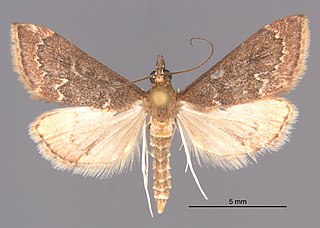
Pyrausta roseivestalis is a moth in the family Crambidae. It was described by Eugene G. Munroe in 1976. It is found in North America, where it has been recorded from California and southern Arizona.

Pyrausta rubricalis, the variable reddish pyrausta moth, is a moth in the family Crambidae. It was described by Jacob Hübner in 1796. It is found in North America, where it has been recorded from Illinois to New York, south to Florida and Louisiana. It is also reported from the west coast, from southern California to Washington. The wingspan is about 15 mm and adults have been recorded on wing from March to October.
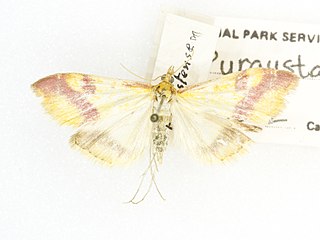
Pyrausta scurralis is a moth in the family Crambidae. It was first observed and described by George Duryea Hulst in 1886. It is found in North America, where it has been recorded/reported in the Canadian provinces of Ontario, Manitoba and Saskatchewan to the US states, California, Arizona, and New Mexico and in Mexico.
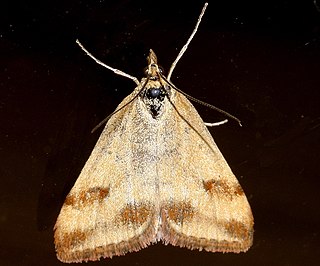
Pyrausta semirubralis is a moth in the family Crambidae. It was described by Alpheus Spring Packard in 1873. It is found in North America, where it has been recorded from southern British Columbia to California, Nevada, Colorado and Arizona. The habitat consists of coastal areas, reaching inland up to altitudes of about 9000 ft.
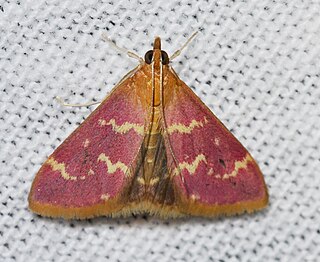
Pyrausta signatalis, the raspberry pyrausta moth, is a moth in the family Crambidae. It was described by Francis Walker in 1866.

Pyrausta subsequalis, also known as the weedfield sable, is a moth in the family Crambidae. It was described by Achille Guenée in 1854. It is found in much of North America, where it has been recorded from southern Alberta and southern British Columbia south to Arizona and New Mexico and east to Florida and north to Ontario. The habitat consists of dry prairie areas.

Pyrausta tyralis, the coffee-loving pyrausta moth, is a species of moth in the family Crambidae. It was described by Achille Guenée in 1854. It is found in the United States, where it has been recorded from New York to Illinois and from Florida to Arizona. It is also found from Mexico to Venezuela, as well as on the West Indies.

Pyrausta unifascialis, the one-banded pyrausta, is a moth in the family Crambidae. It was described by Alpheus Spring Packard in 1873. It is found in North America, where it has been recorded from Quebec west to British Columbia, south to Arizona and California. The habitat consists of forest openings, clearings and fields.
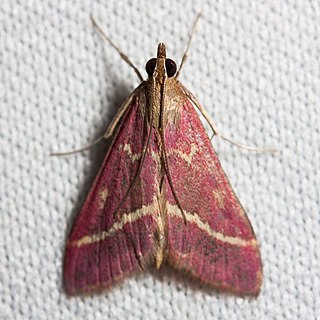
Pyrausta volupialis, the volupial pyrausta moth, is a moth in the family Crambidae. It was described by Augustus Radcliffe Grote in 1877. It is found in North America, where it has been recorded from Oklahoma, Utah, Texas, Colorado, New Mexico, Arizona and California to Chiapas, Mexico.
Pyrausta borealis, the northern pyrausta moth, is a moth in the family Crambidae. It was described by Alpheus Spring Packard in 1867. It is found in North America, where it has been recorded from Newfoundland and Labrador west to British Columbia, north to Alaska and the Yukon. The habitat consists of boreal forests.



















